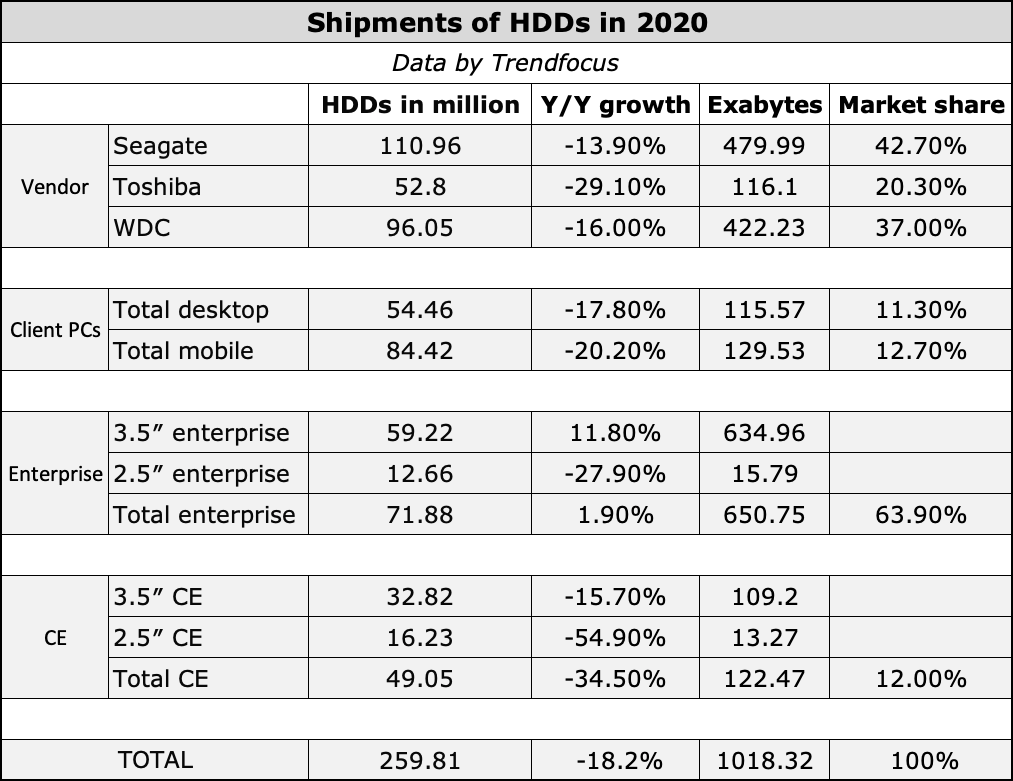Reports Of PC HDDs' Death Have Been Greatly Exaggerated: 139M Shipped in 2020
HDDs for desktops and notebooks are still alive and kicking.
In a world where you cannot cram a hard drive into a modern thin-and-light laptop and a cheap high-capacity 2.5-inch SSD can replace an HDD in a desktop, you would expect consumer hard disk drives to go extinct. Yet, while their unit sales are dropping, sales are still strong at nearly 139 million units per year. In fact, capacities and exabytes shipments of client HDDs are setting records.
Unit sales of all hard drives for all kinds of applications totaled 259.81 million units in 2020, a 13.9% drop year over year, according to data from Trendfocus (via StorageNewsletter).
Despite the rapidly growing popularity of SSDs in the consumer PC space — particularly among enthusiasts — hard drives for desktops and notebooks represent the largest HDD category in terms of units sold. Last year the industry shipped 54.46 million hard drives for desktops as well as 84.42 million HDDs for notebooks. While unit sales of client PC HDDs are dropping, their average capacity is increasing, which is why the capacity of all client HDDs totaled 266 exabytes in Q4 2020.
Seagate was the undisputed market leader last year with a 42.7% market share and 110.96 million HDDs shipped. Western Digital followed its rival with 96 million drives and 37% of the market, while Toshiba was a distant third with 20.3% of the market and 52.8 million units sold.
Since capacities of SSDs shipped in new PCs are sometimes insufficient, many people buy external direct-attached storage (DAS) devices with 2.5-inch or 3.5-inch HDDs inside. Such DAS devices are usually classified as consumer electronics (CE) drives, so they fall into the same category as game consoles and digital video recorders. In total, 49.05 million CE HDDs were sold last year, the data from Trendfocus shows. Unfortunately, it is unclear what exactly (apart from retail DAS and various DVRs) the company includes in the 3.5-inch CE category.
All the hard drives supplied by these three manufacturers in 2020 could store 1081.32 exabytes of data, which seems to be up compared to 2019 and 2018.
Speaking of exabytes. 3.5-inch hard drives for servers, enterprise, and nearline applications commanded over 62% of exabytes shipments last year. In total, the three manufacturers shipped 59.22 million of such HDDs last year, an increase of 11.8% year over year. Meanwhile, the 2.5-inch enterprise-grade hard drives market is dying. It dropped to 12.66 million units in 2020, a decline of 27.9% year-over-year.
Get Tom's Hardware's best news and in-depth reviews, straight to your inbox.
The year 2020 brought no surprises to the HDD market. The general trend of lower unit sales and higher exabyte sales was set several years ago, and it continued in 2020. Meanwhile, many of HDD categories that exist today, including 2.5-inch HDDs for clients, servers, and CE, are set to either decline dramatically or actually cease to exist in the coming years as SSDs replace them.

Anton Shilov is a contributing writer at Tom’s Hardware. Over the past couple of decades, he has covered everything from CPUs and GPUs to supercomputers and from modern process technologies and latest fab tools to high-tech industry trends.
-
For me there are three considerations (1). Cost (2). Physical space (3). Number of ports.Reply
I have 13 x 12TB Seagate NAS drives. 10 in my server and 3 connected to a single and a double enclosure.
To get that capacity in SSDs (The biggest consumer drive available here is 4TB), I'd have to buy 52 4TB drives at A$1600 each, An investment of A$83,200.
External drives are connected by 10Gbps USB. All LAN infrastructure is 10Gbps. The HDDs are the slowest link, but writing at 220MB/s is better than at 112MB/s
The total investment in the NAS drives was A$7150. SSDs are currently 11.63x the price of Spinners.
How would I connect 52 SATA drives? The drives I have connected externally are for low use stuff and backups. The 10 slots on my motherboard are all loaded in the server. So for the SSDs I'd also have to invest in additional hardware to connect the drives. Don't know how much that would cost.
I also don't have the space to house any more equipment. I don;t have a server rack, though I've considered it, heat would be an issue and server hardware doesn't really come with good cooling.
I used to use desktop model drives. The failure rate of those was 100% within warranty periods. Back then warranty was usually 3 years. 100% of all desktop drives I purchased failed in 18 months or less. Those drives were about 20% less cost back then compared to NAS drives.
I dispose of NAS drives in less than 3 years. My failure rate is down to about 1 per 2 years, or about 1 in every 8 drives. I spend about A$2000 per year replacing those drives, but I resell the replaced drives for about A$1400.
HDDs are definitely not dead and won't be until the capacity and price come down to that of HDDs. -
USAFRet Reply
You are offset by the people who have but a single laptop with an SSD.IceQueen0607 said:I have 13 x 12TB Seagate NAS drives. 10 in my server and 3 connected to a single and a double enclosure.
You are waaaaay out on the edge of residential storage needs.
I'm not far behind, though. My NAS has 11 spinners in or attached, and 1x SSD for the system drive. 51TB available space.
